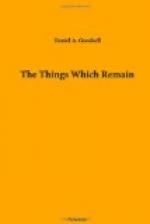[Sidenote: Not an Invention.]
[Sidenote: An Eye-witness Story.]
It seems impossible that the Resurrection could have been an invention or that the account of it could be a work of the imagination. The last is almost as great a miracle as the Resurrection itself. In detail, in naturalness, even in the presence of difficulties and hindrances to easy belief of the story, the narrative seems that of an eye-witness. No reasoning can bring faith, however, to one who denies the miraculous. As a fact, the Resurrection is incapable of naturalistic explanation. To those who deny the miraculous I can only again point out how Huxley cuts out the a priori argument from Hume as worthless. As quoted in his biography, Huxley says: “We are not justified in the a priori assertion that the order of nature, as experience has revealed it to us, can not change. The assumption is illegitimate because it involves the whole point in dispute.”
* * * * *
[Sidenote: Ascent into Heaven.]
[Sidenote: The Ascension.]
[Sidenote: Nature not Wholly Love.]
[Sidenote: Evil and Good.]
Necessarily miraculous also is the doctrine, “He ascended into heaven.” In this He passed from the visible into the invisible; from the conditions of human life to those of the life of a spirit; from the work of redemption to that of intercession. If His resurrection be accepted, His ascension presents no difficulties to faith. This, with His incarnation, and the facts of His earthly life are the manifestation of the tender side of God to the senses even as His wisdom and power are shown to the senses by the facts and laws of nature. As to the doctrine, “God is love,” nature’s word can never be conclusive. In the natural kingdom joy and sorrow, ease and pain, love and hate, kindness and cruelty, trust and terror exist side by side, as do life and death. No man concludes, from nature alone, that God is ruled by love. Because man can not conclude this, Ormuzd and Ahriman are found substantially in all religions, as in that of the Parsees, except in the Christian. Here the warfare is not to be eternal. The victory of good is to come. Divine help is promised, that it may be secured in every soul. The conquest of evil by good is within that Christian omnipotence which Paul knew. “I can do all things through Christ who strengtheneth me.” It requires a Christ to show that the path to rest is through toil; that the way to ease is through suffering; that the highway to life passes through death. Only thus can “mortality be swallowed up of life.”
[Sidenote: The Meaning of Jesus.]
[Sidenote: Christ as Revealer.]
In the unity of the Godhead, Christ is God in manifestation, redemption, intercession, judgment. In the Trinity, in which we must believe God exists, Jesus Christ is the personality expressive, at first visibly and now invisibly, of the tender qualities of the Divine nature which, manifested in part in the world of nature, are there so linked with severity as to require special and peculiar revelation in the person of Jesus Christ in order that God may be understood both as transcending nature and as eternal love.




